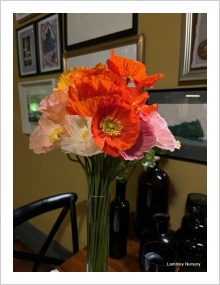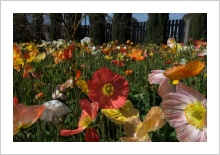Iceland poppies
Now in mid-June the first stems of this season’s Iceland poppies are carrying their hairy, dangling flower buds. In a few days the buds will straighten, the tightly crinkled flowers will push off the bud casing and within a few minutes the crepe paper like petals will unfurl revealing countless stamens. The anthers produce prodigious amounts of pollen. On a fine day honey bees collect this bounty and in return pollinate the flowers. Each pollinated flower will produce a seed pod containing an inordinate number of seeds.
 Poppy seeds can lay dormant in the soil for many years germinating when exposed to light. This gives a clue on their cultivation needs. During January or early February sow a few seeds on the soil surface in individual 5cm tubes, gently water them, keep the soil moist. Seed will take 2 or 3 weeks to germinate. When the second or third set of true leaves develop carefully thin to one plant per pot. Plant out into permanent position during April or early May.
Poppy seeds can lay dormant in the soil for many years germinating when exposed to light. This gives a clue on their cultivation needs. During January or early February sow a few seeds on the soil surface in individual 5cm tubes, gently water them, keep the soil moist. Seed will take 2 or 3 weeks to germinate. When the second or third set of true leaves develop carefully thin to one plant per pot. Plant out into permanent position during April or early May.
Iceland poppies need to make good sized plants before they start blooming after which they won’t put on any more growth. The larger the size the plants make before commencing flowering the more prolific will be the eventual crop.
I lived in the inner-city suburb of Carlton when I first arrived in Melbourne in the early 1960s. I well remember going to Victoria Market on Saturday mornings to buy my weekly victuals to feed my belly. During winter I often bought a bunch of Iceland poppies to feed my soul.
 Pick as the bud starts to show a glimpse of colour, plunge the stems 5cm down into boiling water for a few moments and immediately plunge into cold water. The flowers will quickly open in a vase and give delight for 5 or 6 days.
Pick as the bud starts to show a glimpse of colour, plunge the stems 5cm down into boiling water for a few moments and immediately plunge into cold water. The flowers will quickly open in a vase and give delight for 5 or 6 days.
Iceland poppies are listed in almost all, if not all seed, catalogues as Papaver nudicaule. However P. nudicaule isn’t to be found in Iceland at all rather this domain belongs to the closely related P. radicatum, a widespread Arctic species.
Papaver nudicaule itself grows wild “….from Siberia and Mongolia southwards to the mountains of central Asia as far as Afghanistan”.
There are other closely related species hailing from all the very cold areas of the Northern hemisphere. It is from a combination of these closely allied species that Iceland poppies, as we know them, have developed.
